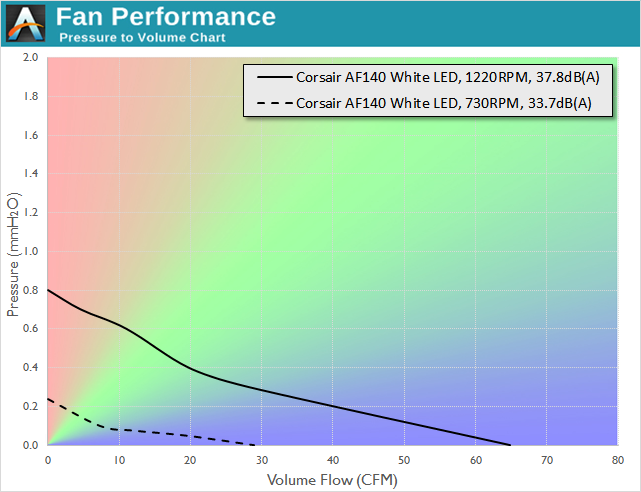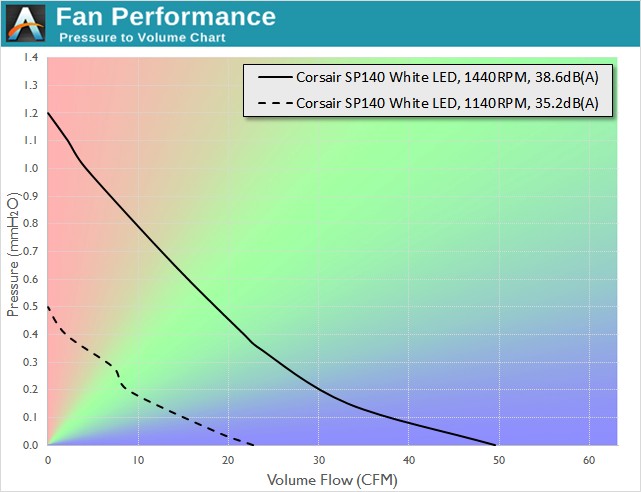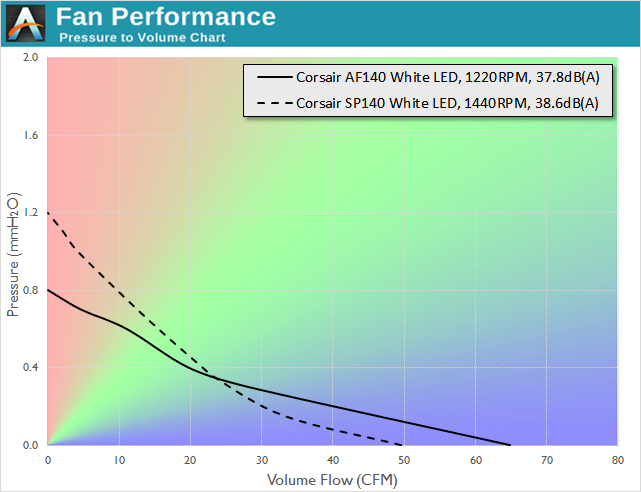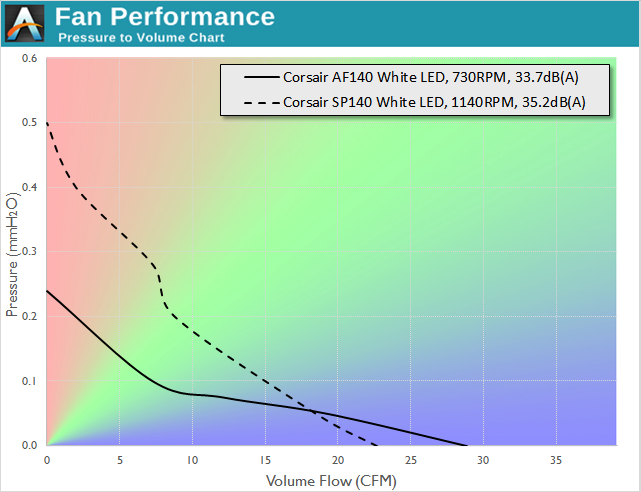The Corsair SP (Static Pressure), AF (High Airflow) 120/140mm Fan Review
by E. Fylladitakis on November 25, 2015 8:00 AM ESTCorsair's 140mm Performance
AF140 White LED Quiet Edition
As mentioned previously, the variation on Corsair's fans means that this one is our 140mm model in the 'High Airflow' (AF) category, focusing on low-impedance (case-fan style) scenarios. The LED versions are not built as sturdy as the non-LED models, and this one comes in with the 'Quiet Edition' moniker as well. Here are the results for the AF140 LED QE fan at high and low voltage settings:
As it can be seen from the above performance chart, the AF140 begins with very low static pressure readings but its airflow increases as the airflow impedance decreases. This increase is dramatic when the airflow impedance pressure drop is below 0.3 mmH2O while the fan is operating at its maximum speed.
SP140 White LED
The Static Pressure line of fans focuses more on the early end of the pressure/volume curve, aiming to get higher airflow at the same pressure while potentially sacrificing the total peak volume flow at zero pressure. Similar to the AF model above, this is a 140mm LED version but not in the quest range. Here are the 12V and 7V results:
As expected by its design and specifications, the SP140 has a good static pressure, nearly 50% better than that of the high airflow AF140. However, its pressure to flow curve declines faster and the SP140, even though it has a higher maximum speed than the AF140, cannot reach very high airflow values.
Comparing the AF140 LED QE and SP140 LED
If we do a direct comparison at the different voltage modes, we get the following for 12 volts:
Then this is for 7 volts (note the different scales on both axes):
Note that their rotational speeds are not the same at either voltage. Still, the slower AF140 can move greater volumes of air when the airflow impedance pressure drop is below 0.3 mmH2O. However, if the airflow impedance is high, the SP140 will clearly provide better performance.














92 Comments
View All Comments
E.Fyll - Wednesday, November 25, 2015 - link
The word impedance is by no means limited to electrical resistance. Actually, electrical resistance and electrical impedance are different things to begin with.I can only assume that you are a new student if you have never heard of mechanical impedance. You definitely need to read more about it.
https://en.wikipedia.org/wiki/Mechanical_impedance
The resistance of a system to airflow is called impedance. Drag is the force that opposes airflow, generated by this impedance.
https://www.google.gr/url?sa=t&rct=j&q=&am...
Hulk - Wednesday, November 25, 2015 - link
Interesting. I have a BS in Mechanical Engineering from Rutgers and never heard the term impedance used to describe resistance to fluid flow. Not even in Fluid Mechanics where we spent about 5 weeks deriving the Navier-Stokes equations, which as you know completely describe all fluid behavior. Of course there isn't a closed form solution to these equations so complicated (real life) situations much be modeled via numerical computation.I have a feeling mechanical impedance is an older term that is rarely used anymore.
I think a much more descriptive term for this article would be to use the term "head" to quantify and describe the resistance to airflow through various computer systems as it relates to cooling. ie maintaining a certain rate of airflow though a case with a filter would have greater resistance (head) than one without a filter and thus require a different pump curve. Sizing pumps, which is what we are really talking about here is all about matching pump curves.
http://www.pricepump.com/pumpschool/psles2.html
But I think what most of us really want to know here is how much air a certain fan can move in a high head (resistance) situation and how much noise is makes, as well as in relatively low head situations. I think perhaps testing through a case with no filter would be a low head situation and though a filter would be a high head case. Perhaps testing though a relatively constrictive radiator would also be useful unless results were similar to the filter case. But once tested we'd know if both tests would be useful in the future.
Anyway, how much air flow (cooling)? How quiet? How long will it last? That's the bottom line.
Hulk - Wednesday, November 25, 2015 - link
Also I think most readers would better understand the term "head" for fluid resistance because it can be quantified as the height of a certain air column. ie pushing air case "x" with a filter is akin to pumping air an air column of "y" height, whereas removing the filter reduces the head (air column) height by z.E.Fyll - Wednesday, November 25, 2015 - link
Well, I can only assume that it depends on the school or the professor. Mechanical impedance is a very widely used term. You could run a Google Scholar search and you'd find thousands of papers published only this year.I think that I mentioned that already, but resistance and impedance are different figures. Resistance includes only Real parts. Impedance accounts for the Reactive parts as well.
Head is not resistance. Head is a measure of performance that is based on pressure. Practically, it can be converted from the left axis directly. Head = Pressure/404.3 for air, where head is in ft and pressure is in mmH20. It should generate a similar graph with a different Y axis.
Hulk - Wednesday, November 25, 2015 - link
Head is a measure of performance based on pressure and performance is exactly what you are trying to determine here. That's why I said head may be a better parameter rather than impedance. If you've worked in industry you've probably noticed no one (at least on the US East coast when it comes to pipelines or flow) talks about impedance but rather refer to "head loss." It's a working term, not a school/theory term.Oxford Guy - Thursday, November 26, 2015 - link
"It's a working term, not a school/theory term." That doesn't make it better. It just makes it common.Cold Fussion - Thursday, November 26, 2015 - link
I too have mechanical engineering degree and have never seen the term impedance used like how you use it in the fan curve graphs. Whenever I hear impedance used in a fluids context, it's normally electrical people trying to explain the resistance of a flow due to pressure. In the text books I've studied, what you describe as impedance in the curves is what would have normally described as the system curve or the system head or something along those lines.On a side note I find it pretty ridiculous that you guys have to actually do testing in order to get the fan curves instead of manufacturers providing a datasheet that has the fan curves on it (like they should be doing). I guess that shows the state of PC industry. I appreciate you guys doing real fan testing though and providing this data.
Erazor51 - Thursday, November 26, 2015 - link
E=mc2Freaky_Angelus - Friday, November 27, 2015 - link
LoL, let's throw titles as arguments...I've heard of impedance being used in fluid dynamics and, like the used mmH2O instead of Pascal, it's an older term used mainly by the 'old guard'. I would however recommend Anandtech to next time use Pa. as a term as you'll not find high tech fan-curve sheets using mmH2O (anymore).
On a side-note, if fan reviews are going to be used.. I would like to suggest a push-pull efficiency review on liquid coolers.
In the industry we almost always use pull configurations through heat exchangers as underpressure draws more evenly through an exchanger than otherwise possible with the momentum of the air. I don't have enough liquid coolers systems to be able to make a review, but my own pc is a degree lower. Considering some people might like to know these kind of things and I enjoyed to read something this close to my actual work, who knows.
Ohw, and just for bs argumentation and to be part of this thread: MSc.
mctylr - Wednesday, December 23, 2015 - link
I want to echo [Freaky Angelus]'s comments; mmH2O (millimeter of water) is a dated unit of measurement that isn't the preferred unit in any context as far as I know. It was essentially a metrication variation of inches of Mercury (inHg) that should be left to the history books. Pascals (Pa) would be the unit used for scientific literature in US and abroad. I'm not familiar with US engineering / commercial preferences for fluid dynamics and air flow/fan measurement to be sure, but I suspect they would prefer Pascals over mmH2O as well.